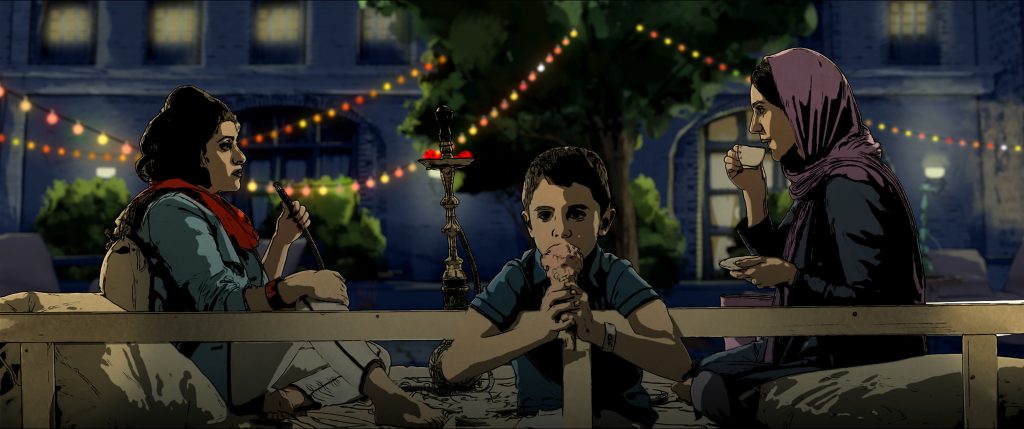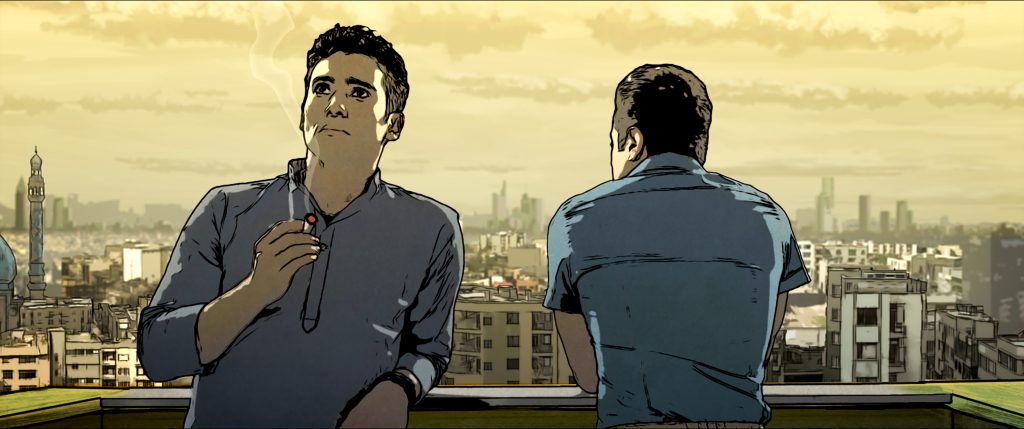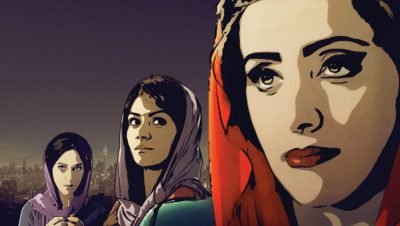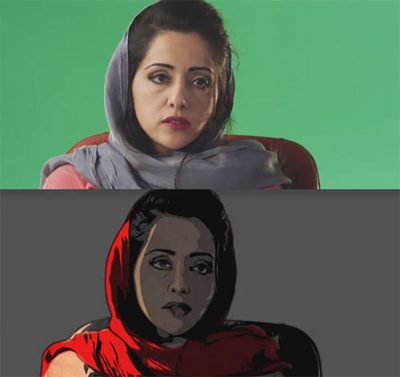Being Taboo in Tehran with director Ali Soozandeh
We go behind the scenes of the incredible TEHRAN TABOO with writer / director with Ali Soozandeh

Pari, Elias and Sara in a Restaurant
What is the origin of the project? Is it adapted from any existing material?
TEHRAN TABOO is an original screenplay, not based on a novel. The idea came to me a few years ago when I overheard a conversation between two young Iranian men in the subway who were talking about their experiences with girls. They mentioned a prostitute who brought her child along on the job. This made me think about themes on sexuality in Iran. I began researching social media and I explored my own memories of dealing with such issues when I was in my teens and twenties, and the story developed from there.
Was it always your intention to make an animation film?
The initial goal was not about making a rotoscoping animation film, but animation is my main professional background. I have also worked as a camera operator, photographer, painter, storyboard and VFX artist. The most important thing for me was to make the story work. For this project, the problem with shooting a live-action film was the location. Tehran was not an option, for obvious reasons. I watched some films which used Morocco or Jordan in place of Iran but this was not very convincing. After many discussions and tests, we concluded that the rotoscoping technique would be the best way to go. I chose that technique because it allows us to feel the characters more realistically despite the animation.
Tell us about your relationship to Iran.
I was born in Iran and lived there until I was 25. I’m the only one in my family who now lives abroad. I was nine years old when the Islamic revolution came. I felt the impact when boys and girls were suddenly separated in school. This was the rest of many shattering experiences. At 25, I emigrated and I have been living in Germany since 1995. Of course I still love Iran and my people, who are among the best in the world when it comes to enduring hardships. Research and rejection within our society for the film has given me a very different image of Iran. I think I understand better the circumstances, how complex the society is and why there is no simple answer. My relationship to Iran is much closer since making the film.

Babak smokes weed
Tell us about the taboos referred to in the movie’s title.
By making this film, I wanted to break the silence that is common practice in Iran. I would say breaking taboos is a way to protest against the restrictions. In Iran, legal prohibitions and moral restrictions are the forces that shape everyday life. When sexuality is regimented strongly, people can become very industrious at working around the many taboos. Iranians are a creative people and learn quickly how to handle the prohibitions and work around the restrictions. We find places free from rules. To compensate for forced public fronts, private life can go out of bounds in regards to sex, alcohol, drugs. The lack of freedom can push people into living with double standards. TEHRAN TABOO focuses on these double standards used to circumvent sexuality in Iran. This creates many social complications, which occasionally manifest themselves in absurd situations, often comic.
Explain the atmosphere of secrecy and paranoia that is often experienced in the film.
In the middle class district where TEHRAN TABOO is set, restrictions come from people’s mindsets as much as the actual laws. Family honour is much more important in Iran than in Europe. Iran has a society where social contacts are very important and play a big role in achieving success. An individual and his or her whole family can lose their honour for an extramarital relationship, of which the slightest is forbidden by law. But being sent to prison and paying the fine are not nearly as detrimental as the police releasing such information to the public. This means all your relatives, all your neighbours find out about your crime. For you and your family, it means complete loss of honour.

The women are crucial to the storyline in your film, what is the that women play in Iranian society.
The images Westerners have about Iran are always very distorted and full of clichés. They are characterized by stereotypes ranging from the exoticism of «1001 Nights» to the nuclear dispute to the fierce Islamic regime. But the reality seen on Tehran streets is much more diverse. Women in Iran are often more educated than men and have a more visible role in daily life than in many other Islamic countries, such as Saudi Arabia. But there is no one modern Iranian woman. There are many types, from religious fundamentalists to Western feminists. Of course, the latter have no means to express themselves in public. I was especially interested in the role that women play and must play in Iranian society’s game of virtues. They are the ones who suffer most. At the same time, women are expected to impose the rules and taboos that restrict their liberty onto the next generation.
Wat about your characters’ spirit and the tone they give to the film.
I believe people and their dreams are similar everywhere in the world. Only the circumstances are different. Any audience anywhere could probably identify with these characters. They all suffer in one way or another from the taboos of sexual relationships and the restrictions of Iranian society. They are victims, but also offenders at the same time. No one in the film is absolutely good or bad. A character can seem very offensive by his actions, but we can better understand his behaviour when we discover the backstory.
The film adopts in large parts the perspective of a small boy. Not wanting to make an overly dark film, I preferred to adopt the optimistic, hopeful and colourful perspective that children usually have on life. This and careful storyboarding enhance the tone and look of a graphic novel or comic book given by the rotoscoping technique.

What was the technical process involved in the making of your film.
Upon finishing the storyboards and casting, we started shooting in green screen with the actors. During this stage, the work is with a normal film crew and camera in studio. The first step in the animation stage is pre-visualisation. We couldn’t go to the edit stage with only green screen footage. We needed to create placeholders for backgrounds. After the editing was done, we started the animation process. We created the final backgrounds (which are a combination of 3D-elements and drawn images) and the drawn characters separately. Finally, we combined all of the elements in the compositing stage, combining all the elements to provide the final image. It took 13 months just to shoot and complete the animation process, and more than 40 artists were involved.
Will you continue in the field of animation or do you see yourself working on live-action films?
I feel safe in the animation world, but I can imagine working on live-action films too. It depends strongly on the story. If live-action would be the better way to tell a story, I would not necessarily make an animated film.
